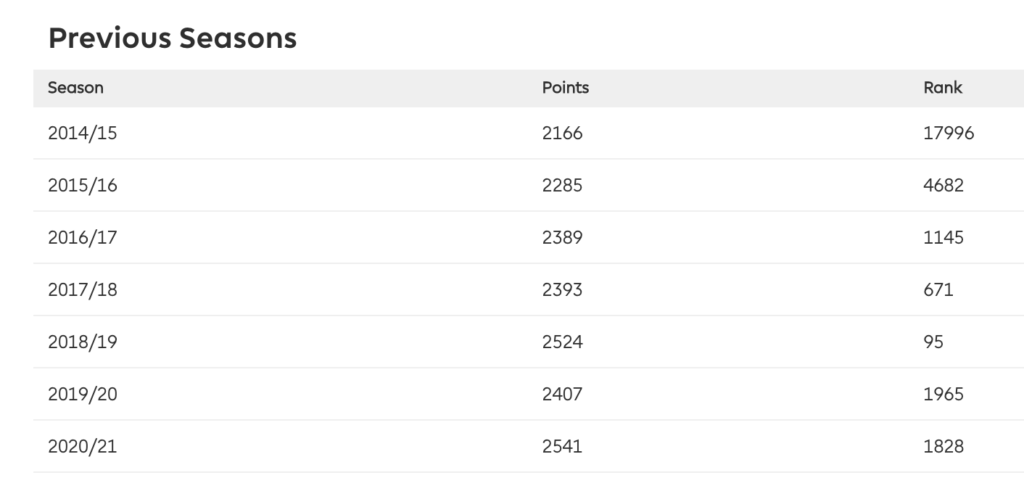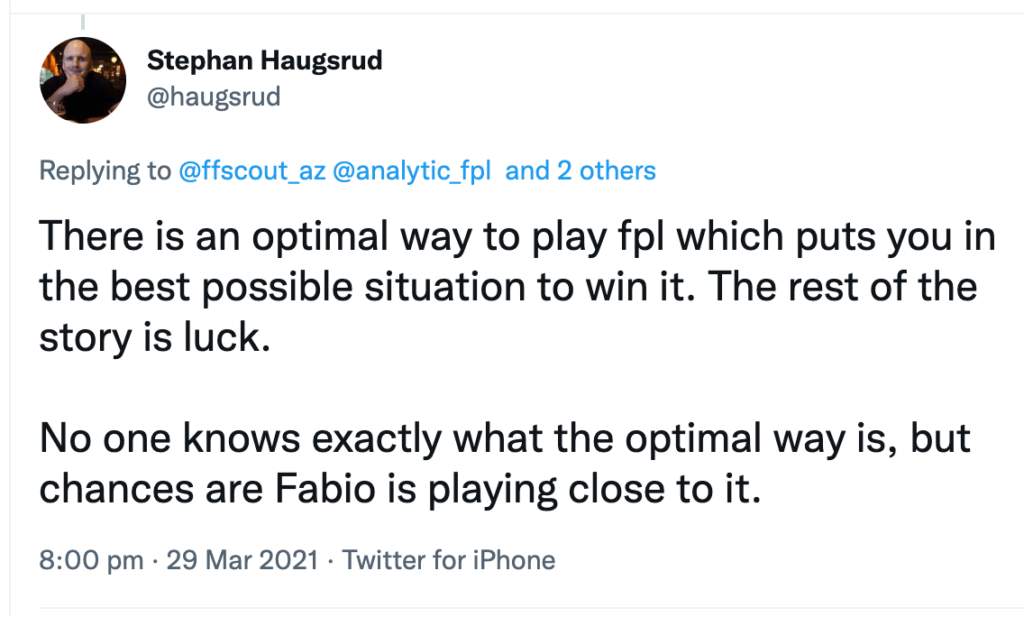Introduction
Fabio Borges is the current career number 1 in the FFScout Hall of Fame and his FPL season history (shown below) makes me want to cry.

As Stephan Haugsrud of FPL Surgery once said – and Stephan is a guy who is not too shabby at FPL himself, finishing 150 OR last season – Fabio may be the closest thing we have to an algorithm that has cracked FPL.

But the million-dollar question is: how does Fabio do it? Despite being a pro pundit, he doesn’t spoon-feed us the secret to his success. He doesn’t give too much away, but, if you read old interviews, he does give us tantalising clues. Looking at this brilliant article from TopMarx, and Fabio reveals:
“Four seasons ago, I found out about xG. And since then it’s the only stat I use (along with xA) when making FPL decisions. Of course, it is not perfect but if the model is reliable – and you know how to interpret it – I believe it is, by far, the most useful stat for FPL.
I make my own xG tables which I try to update as often as possible. I put a lot of work into it and I try to adjust players’ xG numbers by using their career xG Delta (when the sample is big enough).
There are players who are consistent xG overperformers and others that underperform the model for long periods of time. For example, Kevin De Bruyne overperforms the model by 35% while Jesus underperforms it by around 25%.
I think it’s important to use xG Delta because you can easily be fooled by some great xG numbers from a particular player who is a consistent underperformer/bad finisher. And vice versa.”
I found this quote very interesting. Has Fabio inadvertently revealed the ingredients to the secret sauce of his FPL success?
Career xG Data
xG is a marmite stat, but even those FPL managers who hate it must admit it is clearly working a treat for Fabio. But what does he mean by “career” xG data? And is this where he gets his edge by looking at a long enough time period that variance is stripped out and what you are left with is very reliable numbers that you can put your mortgage and your 1 free transfer on?
To look at this, I downloaded from the FFS Members Area a mega spreadsheet of expect data from the last 5 seasons. Then I took a look at a few of the most popular transfer targets from this international break, starting with Man City’s Joao Cancelo. The idea is to see if we should be bringing in the player by looking at the largest possible sample size of data.
To date, Cancelo has started 47 games since he has been at Man City and in that time generated a “career” expected assists (xA) figure of 8.53. However, season after season, he has underperformed his xA to arrive at a total of minus 4.53. This suggests he flatters to deceive – he has a history of creating lots of chances that never lead to goals and never get him the assist points we expect. Perhaps his teammates and the lack of a clinical striker to convert these chances has let him down in recent years? I’m not saying that Cancelo is or isn’t essential, but rather trying to show how looking at career data can give us deeper insights into how a player will perform in the future.
Now let’s take a look at perhaps Fabio’s favourite player: Mo Salah, who is also in the top 5 for transfers in this week.
We can see from his very juicy career data that there are very few minus figures. This is a player who season-after-season outperforms his expected data (truly the sign of a world-class player). Across the last 5 seasons, his xGI Delta is +19.11 (albeit his exceptional first season does help to power this plus number). This is a guy you can rely on – his xG data never flatters to deceive; he always hits what he is expected to and often surpasses it. If we were looking at one season’s worth of data with Salah and he was posting very strong xG stats, it is tough to know whether this can be maintained. But once you start looking at his career data and see the consistent trend, you know you can rely on the data and you can rely on the player.
What’s also interesting about Salah’s historical data is his goal conversion rate. In the 2017/18 season when he scored over 300 points and broke FPL records, his goal conversion rate was 22.2% of shots. So far this season, it is very close to that at 21.4%. Is he on course for another 300-point season? Keep a close eye on his goal conversion rate as it progresses in the gameweeks to come this season, because if it falls to around the 15% mark, we’re looking at something closer to 200 points like we’ve seen in the last 3 seasons.
Conclusion
With a wealth of data in the mega spreadsheet, this is just the tip of the iceberg. The potential and the opportunities for looking at career xG data is tremendous. It allows you to properly audit your transfers in to see if the player you are considering is a flash in the pan or if they are the real deal. By checking their season-after-season figures, you perhaps have the biggest clue you can possibly get in knowing how a player will perform for your team in the future.


